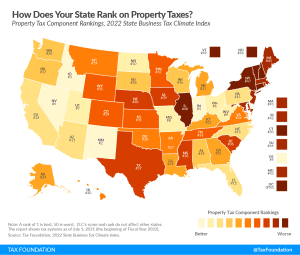Doing Tax Policy at the Ballot Is Not for the Faint of Heart
Some tax ballot initiatives will be straightforward, some will be complex, and—let’s be honest—some will be a drafting nightmare.
5 min readHow does Florida’s tax code compare? Florida does not have an individual income tax. Florida has a 5.5 percent corporate income tax rate. Florida also has a 6.00 percent state sales tax rate and an average combined state and local sales tax rate of 7.00 percent. Florida has a 0.71 percent effective property tax rate on owner-occupied housing value.
Florida does not have an estate tax or inheritance tax. Florida has a 38.6 cents per gallon gas tax rate and a $1.339 cigarette excise tax rate. The State of Florida collects $4,339 in state and local tax collections per capita. Florida has $6,163 in state and local debt per capita and has an 82 percent funded ratio of public pension plans. Overall, Florida’s tax system ranks 4th on our 2024 State Business Tax Climate Index.
Each state’s tax code is a multifaceted system with many moving parts, and Florida is no exception. The first step towards understanding Florida’s tax code is knowing the basics. How does Florida collect tax revenue? Click the tabs below to learn more! You can also explore our state tax maps, which are compiled from our annual publication, Facts & Figures 2024: How Does Your State Compare?

Some tax ballot initiatives will be straightforward, some will be complex, and—let’s be honest—some will be a drafting nightmare.
5 min read
Property taxes are the primary tool for financing local government and generating state-level revenue in some states as well.
5 min read
The mix of tax sources states choose can have important implications for both revenue stability and economic growth, and the many variations across states are indicative of the different ways states weigh competing policy goals.
29 min read
The FDA’s proposal to ban flavored cigars would carry significant revenue implications for many state governments.
7 min read
However well-intended they may be, sales tax holidays remain the same as they always have been—ineffective and inefficient.
43 min read
While many factors influence business location and investment decisions, sales taxes are something within policymakers’ control that can have immediate impacts.
12 min read
Among the 46 states that held legislative sessions this year, structural state tax reform and temporary tax relief measures were recurring themes.
13 min read
If the policy goal of taxing cigarettes is to encourage cessation, vapor taxation must be considered a part of that policy design.
4 min read
The Kansas experience is so infamous that “what about Kansas?” is almost guaranteed to be a question—sometimes as a retort, but often a genuine expression of concern—any time any state explores tax relief. But what about the other two dozen states that have cut their income taxes since then?
6 min read
Which states have the highest property taxes in 2022? See how your state compares in property taxes across the United States
3 min read